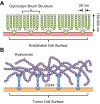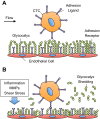Physical biology in cancer. 3. The role of cell glycocalyx in vascular transport of circulating tumor cells
- PMID: 24133067
- PMCID: PMC3919988
- DOI: 10.1152/ajpcell.00285.2013
Physical biology in cancer. 3. The role of cell glycocalyx in vascular transport of circulating tumor cells
Abstract
Circulating tumor cells (CTCs) in blood are known to adhere to the luminal surface of the microvasculature via receptor-mediated adhesion, which contributes to the spread of cancer metastasis to anatomically distant organs. Such interactions between ligands on CTCs and endothelial cell-bound surface receptors are sensitive to receptor-ligand distances at the nanoscale. The sugar-rich coating expressed on the surface of CTCs and endothelial cells, known as the glycocalyx, serves as a physical structure that can control the spacing and, thus, the availability of such receptor-ligand interactions. The cancer cell glycocalyx can also regulate the ability of therapeutic ligands to bind to CTCs in the bloodstream. Here, we review the role of cell glycocalyx on the adhesion and therapeutic treatment of CTCs in the bloodstream.
Keywords: adhesion; drug delivery; metastasis; microvasculature.
Figures




Similar articles
-
Role of deformable cancer cells on wall shear stress-associated-VEGF secretion by endothelium in microvasculature.PLoS One. 2019 Feb 22;14(2):e0211418. doi: 10.1371/journal.pone.0211418. eCollection 2019. PLoS One. 2019. PMID: 30794550 Free PMC article.
-
Flow-regulated endothelial glycocalyx determines metastatic cancer cell activity.FASEB J. 2020 May;34(5):6166-6184. doi: 10.1096/fj.201901920R. Epub 2020 Mar 13. FASEB J. 2020. PMID: 32167209 Free PMC article.
-
Mechanisms of triple-negative breast cancer extravasation: Impact of the physical environment and endothelial glycocalyx.FASEB J. 2024 Jul 15;38(13):e23785. doi: 10.1096/fj.202400380R. FASEB J. 2024. PMID: 38949120 Review.
-
Extravasation of immune and tumor cells from an endothelial perspective.J Cell Sci. 2024 Nov 1;137(21):jcs262066. doi: 10.1242/jcs.262066. Epub 2024 Nov 12. J Cell Sci. 2024. PMID: 39530179 Review.
-
The role of galectins in mediating the adhesion of circulating cells to vascular endothelium.Front Immunol. 2024 May 22;15:1395714. doi: 10.3389/fimmu.2024.1395714. eCollection 2024. Front Immunol. 2024. PMID: 38840921 Free PMC article. Review.
Cited by
-
Just Look! Intravital Microscopy as the Best Means to Study Kidney Cell Death Dynamics.Semin Nephrol. 2016 May;36(3):220-36. doi: 10.1016/j.semnephrol.2016.03.009. Semin Nephrol. 2016. PMID: 27339387 Free PMC article. Review.
-
Glyconectin Cell Adhesion Epitope, β-d-GlcpNAc3S-(1→3)-α-l-Fucp, Is Involved in Blastulation of Lytechinus pictus Sea Urchin Embryos.Molecules. 2021 Jun 30;26(13):4012. doi: 10.3390/molecules26134012. Molecules. 2021. PMID: 34209220 Free PMC article.
-
The role of shear stress and altered tissue properties on endothelial to mesenchymal transformation and tumor-endothelial cell interaction.Biomicrofluidics. 2017 Jul 17;11(4):044104. doi: 10.1063/1.4991738. eCollection 2017 Jul. Biomicrofluidics. 2017. PMID: 28798857 Free PMC article.
-
Alterations in cancer cell mechanical properties after fluid shear stress exposure: a micropipette aspiration study.Cell Health Cytoskelet. 2015 Jan 9;7:25-35. doi: 10.2147/CHC.S71852. Cell Health Cytoskelet. 2015. PMID: 25908902 Free PMC article.
-
Degradation of the endothelial glycocalyx in clinical settings: searching for the sheddases.Br J Clin Pharmacol. 2015 Sep;80(3):389-402. doi: 10.1111/bcp.12629. Epub 2015 May 22. Br J Clin Pharmacol. 2015. PMID: 25778676 Free PMC article. Review.
References
-
- Arisaka T, Mitsumata M, Kawasumi M, Tohjima T, Hirose S, Yoshida Y. Effects of shear stress on glycosaminoglycan synthesis in vascular endothelial cells. Ann NY Acad Sci 748: 543–554, 1995 - PubMed
-
- Ashkenazi A. Targeting death and decoy receptors of the tumour-necrosis factor superfamily. Nat Rev Cancer 2: 420–430, 2002 - PubMed
Publication types
MeSH terms
Grants and funding
LinkOut - more resources
Full Text Sources
Other Literature Sources

